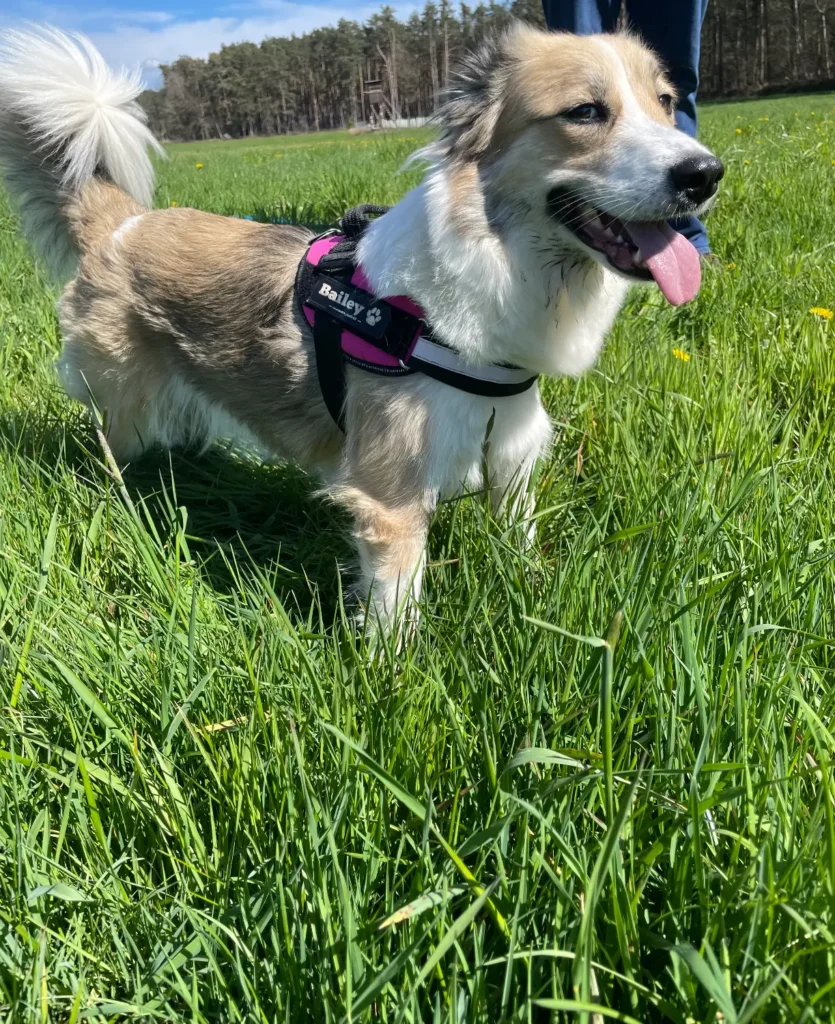Bailey’s allergy story: A long road to a happy dog
Bailey’s allergy story: A long road to a happy dog
Bailey’s allergy story: A long road to a happy dog
Bailey’s allergy story: A long road to a happy dog
6. Februar 2025
Feedback: 0
Bailey’s battle against allergies is often hard to detect, especially when symptoms are diverse and the causes are not obvious. Our dog Bailey, a loyal rescue dog, presented us with exactly this challenge. It was a long process full of surprises until we discovered how many things Bailey was allergic to. But with patience, research, and adjustments, we were able to improve her life sustainably. Here is Bailey’s story.
- First signs: A dog that wasn’t itself
- Our solution: The allergy test
- The diagnosis: much more than just an allergy
- Nutrition: A new start for Bailey’s well-being
- Bailey’s new menu
- Environmental allergies: The battle against grasses
- Our measures against pollen
- Setbacks: When things do go wrong
- The move to Spain: an improvement
- Our conclusion: allergies are manageable
First signs: A dog that wasn’t itself
Bailey was a lively and loving dog from the very beginning. But at some point, we noticed that she was scratching herself frequently—especially her ears and paws. Her skin developed red spots, and she repeatedly suffered from digestive issues like diarrhea and bloating. Most noticeably, after walks, especially on grassy fields, Bailey was often extremely exhausted. She seemed drained, even though we spent the same amount of time outside as always.
At first, we attributed the symptoms to stress. As a rescue dog, Bailey had a difficult past, and we thought she just needed time to adjust to her new home. But the problems worsened, and it became clear that we had to take action.
Our solution: The allergy test
After some research, we decided to have an allergy test done—not at the vet, but through a specialized company we found online. The process was incredibly simple:
◉ We were sent a test kit.
◉ We took a small amount of Bailey’s hair and a blood sample and sent them in.
◉ The results came within a few days – and they were more extensive than we had expected.
The diagnosis: much more than just an allergy
Bailey was not only allergic to one thing, but to a whole list of things. These included:
◉ Cereals: Especially wheat and barley, which are contained in many animal feeds.
◉ Vegetables: Apples and parsnips – foods we often gave her because we thought they were healthy.
◉ Oils: Especially rapeseed oil, a common ingredient in dog food.
◉ Pollen: grasses and flower pollen, which are omnipresent in Germany, especially during the flowering season.
◉ Additions: Even some artificial preservatives that were contained in snacks and ready-made food.
The diagnosis explained many of the problems Bailey had. The itching, digestive issues, and constant exhaustion after walks—all of this was due to her allergies. Now we finally knew what was going on and could begin taking targeted actions.
Nutrition: A new start for Bailey’s well-being
The first and most important step was a complete change in her diet. We decided against ready-made hypoallergenic foods and instead prepared her meals ourselves.
Bailey’s new menu
◉ Meat: Chicken, offal and fish, depending on availability.
◉ Vegetables: carrots, zucchini and pumpkin (no parsnips!).
◉ Carbohydrates: potatoes and sweet potatoes, as they are better tolerated than rice.
◉ Oils: High quality coconut oil or salmon oil as the fat source.
We made sure that Bailey’s food contained all the essential nutrients and supplemented her meals with vitamins and minerals. Since this change, digestive problems have become a thing of the past.
Environmental allergies: The battle against grasses
In addition to food allergies, environmental allergies were particularly challenging for us. In Germany, where meadows and fields are ubiquitous, it was nearly impossible to completely avoid grass pollen.
Our measures against pollen
◉ 1. Paw care after walks: After each outing, we cleaned Bailey’s paws with a damp cloth to remove pollen residue.
◉ 2. Brushing the coat: During the pollen season, we brushed Bailey regularly to remove allergens from her coat.
◉ 3. Adapt walks: We avoided Meadows and Fields as far as possible and instead chose paths on Asphalt or in the forest.
◉ 4. Air purifiers in the home: To reduce pollen pollution in the home, we used an air purifier.
Despite these measures, the pollen season remained a challenge. However, through the combination of these strategies, Bailey’s condition significantly improved.
Setbacks: When things do go wrong
Of course, not everything went smoothly. One time, Bailey grabbed a fallen apple from the kitchen—the reaction didn’t take long to show. She had diarrhea and was visibly restless. Such setbacks remind us of how important it is to stay vigilant.
Even walks during the blooming season weren’t always avoidable. On particularly bad days, Bailey still showed symptoms like itching and exhaustion.
The move to Spain: an improvement
An unexpected turn of events came when we moved to Spain. Here, the pollen from grasses and flowers is less intense, and the drier air seems to be beneficial for Bailey. We’ve also chosen walking areas that are less dominated by grasses.
Since then, Bailey has appeared much more relaxed and fit. She enjoys her outings again without being exhausted afterward, and her skin problems have almost disappeared.
Our conclusion: allergies are manageable
Bailey’s story has shown us that allergies can be a challenge, but they are not a reason for despair. With patience, adjustments, and a bit of creativity, we managed to improve her life.
The important thing is to take the symptoms seriously and get to the root causes. A comprehensive allergy test can be the key to finding the right solutions – just like with Bailey. Today, she is a happy, healthy dog who can fully enjoy life again.
Happy dogs, happy life – share this post with your friends, leave us your experiences in the comments, and stay tuned to not miss any tips for a happy dog life!
Yours, Bailey and her owner.

Wir sind zwei deutsche Auswanderer und auf emigres-life nehmen wir Dich mit auf unsere Reise in ein neues Leben.
In unserem Projekt schwingt das Pendel meist in Richtung stressig oder chaotisch und weniger in Richtung tiefenentspannt.
Wenn du also wissen willst, in welches Fettnäpfchen wir als nächstes treten oder welche Hürden vor uns liegen und wie wir sie überwinden, dann bleib dran.
Nächster Blogpost
Vorhergehender Blogpost
Baileys Allergiegeschichte: Ein langer Weg zum glücklichen Hund



 Pin it!
Pin it!

